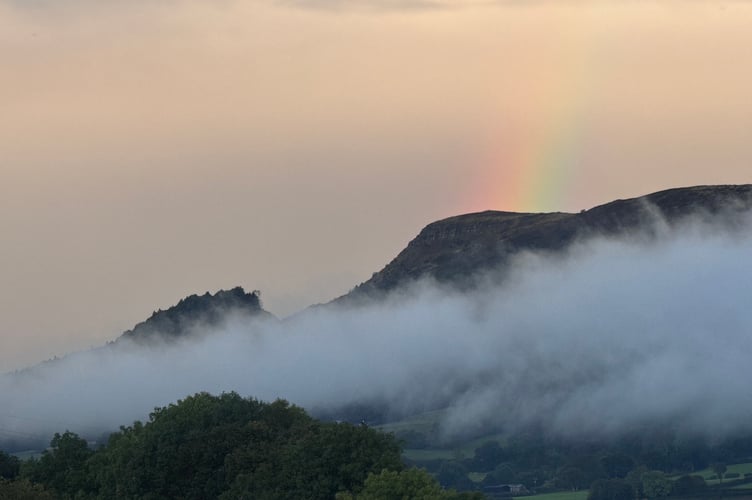At the end of a rainbow, you’ll sometimes find a pot of gold but if you’re really lucky you’ll sometimes find a mountain in Wales as these pictures poignantly prove.
Standing on the outskirts of Abergavenny, in splendid isolation from the other six hills which surround and guard the town, stands the Skirrid Fawr.
This symmetrical oddity stands aloof and alone, and its scarred and broken appearance gives it the impression of a perpetual outsider.
Although lacking the stature of the nearby Blorenge and the SugarLoaf, the Skirrid has an undeniable presence that invites the curious passer-by to question just how this curious and distinctive mound of earth situated on the eastern end of the Black Mountain range is often called the Holy Mountain or Sacred Hill.
Myth and mystery surround the Skirrid, and its very name was forged in the furnace of folklore and fable.
Adopted from the Welsh phrase Ysgyryd Fawr, Skirrid Fawr translates as ‘shattered great’.

The Skirrid got this striking name because of its distinctive shape which appears as if some giant or beast from an age before history had slashed and gouged out a part of the hill and left a desolate hollow and gnawing absence in its wake.
When the sun is full, the sky is blue, and all is well in our fair age of reason and enlightenment it’s difficult to imagine the Skirrid got its ‘split personality’ from anything other than a land-slip which occurred during the Ice Age.
Yet when the moon is full, the shadows creep, and the primal memories of darker days hold sway, it is easy to believe that the Skirrid was split in two due to the terrible wrath of the devil himself.
The story goes that Satan flew into a furious rage after failing to recruit the Archangel Michael into the ranks of the fallen. In a vile temper, the horned one stamped like a toddler having a tantrum upon the Skirrid and created the mount’s distinctive shape.
Another tale suggests that the devil was having a heated debate with local legend Jack O’ Kent about which was bigger, the Sugar Loaf or the Malvern Hills. Disgusted that Jack was right, old Nick collected a huge apron of soil which he intended to dump over the Malvern hills and make them bigger in stature than the Sugar-Loaf. His plan backfired. The apron split and the soil crashed all over the Skirrid and formed the tump at the northern end.
Another theory was that Noah’s Ark passed this way during the great flood when Abergavenny and its seven hills laid beneath the water, and the hill of that great ship ploughed through the once intact Skirrid.
A legend popular with locals suggests the dramatic landslide was caused by an earthquake or a bolt of lightning that hit the hill at the exact moment Christ was crucified.
Whatever the truth, the earth from the Skirrid has been considered holy and fertile for time out of mind. In days gone by it was often scattered on coffins and has been used in the foundations of churches.
Take a trip to the top of the Skirrid today and you’ll still find the remains of the ruins chapel of St Michael’s, an Iron Age hill fort, and a curious stone which is known as The Devil’s Table. So-called because at the tail-end of the nineteenth century, a man who lived on the Skirrid gave out advice and magical gifts to anyone who placed money on the table.
Whether you hold any truck with the old superstitions is up to the individual, but today, people still make pilgrimages to the Skirrid in as great numbers as they did in times gone by. And the instinct that calls us to the high and lonely places of this isolated island or ours remains the same - the need to connect with something natural, timeless, and majestic.




Comments
This article has no comments yet. Be the first to leave a comment.